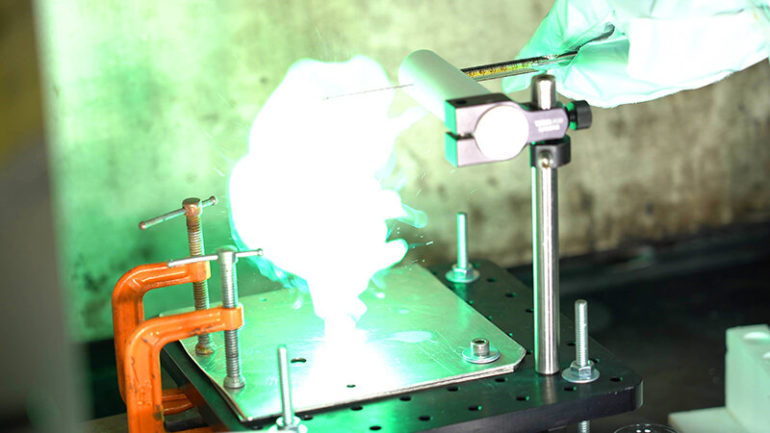When SpaceX’s Crew Dragon capsule splashed down off the Florida coast in August following its first crewed mission, the two astronauts inside could not exit the capsule immediately. Technicians outside had to confirm there were no airborne vapors from hydrazine, a highly toxic fuel used by the vehicle’s hypergolic thrusters.
Now, Purdue University combustion researchers are investigating a safer and less toxic hypergolic propellant, studying its explosive reaction with a new technique involving both visible and infrared high-speed cameras. Hypergolics are substances that instantly ignite when they come into contact with each other.
“Hypergolics have been used all the way back to the Apollo era and before,” said Steven Son, Purdue’s Alfred J. McAllister Professor of Mechanical Engineering, and an expert in energetic materials such as propellants, explosives and pyrotechnics. “They can be stored at room temperature, and they instantly ignite when mixed, which makes them more versatile and reliable than cryogenic fuels.”
Although their use in rocketry is well-documented, current hypergolic fuels also are notoriously dangerous for humans to handle, and bad for the environment.
“We want to develop hypergolic fuels that have good performance, but are also much less toxic,” Son said. “And that’s why we have been experimenting with ammonia borane.”
Unlike most other hypergolic fuels, ammonia borane (NH3BH3) is a solid material, stable in typical atmospheric conditions. Because of its hydrogen density, it was first developed as a solid-state storage medium for hydrogen. But combustion researchers have recently discovered its hypergolic properties, which could be used as part of a hybrid propellant.
“Before this can be used in the real world, we have to understand the fundamental combustion science governing its behavior,” said Chris Goldenstein, a Purdue assistant professor of mechanical engineering. “We are using a new approach that combines visible and infrared imaging to characterize the combustion process.”
Their work has been published in Proceedings of the Combustion Institute.
Infrared imaging allows researchers to see the chemical composition of the flame throughout the combustion process.
“Every molecule has a unique spectral fingerprint,” Goldenstein said. “By looking for specific wavelengths of light, we can identify where in space certain molecules are distributed and know how complete the combustion process is. Many of the desired wavelengths are not visible to the naked eye, and infrared imaging is the only way to see them.”
Because the reaction takes place in just a few milliseconds, the researchers use specialty cameras capable of capturing at least 2,000 frames per second. The high-speed video reveals a remarkable and rapidly expanding green flash, demonstrating the power of hypergolic substances.
“We generally start with very small samples,” said Michael Baier, a Ph.D. student in Purdue’s School of Aeronautics and Astronautics, who conducts the experiments at Zucrow Labs. “We use just a little powder of the ammonia borane, and above it is a syringe that dispenses a microliter droplet of the oxidizer, which, in this case, is white fuming nitric acid. Even then, it makes a pretty big bang. Those few milliseconds give us all the data we need to characterize the ignition.”
Son said, “Thanks to infrared imaging, we saw a lot of BO2 signal, which was surprising to us. This indicates that ammonia borane is achieving complete combustion even better than conventional boron fuels.”
Although ammonia borane may be less toxic than traditional hydrazine-based hypergolics, it’s still fairly dangerous to work with, as are all energetic materials. But Zucrow Labs has been researching propulsion technologies since 1948 and is one of the few labs in academia that is fully equipped to study energetic materials.
“To be able to handle these materials safely and work with these kinds of propellants is unique,” Son said. “Purdue is one of the few places that is able to do this kind of research.”
Zucrow’s capabilities are part of the reason why the Army Research Lab chose Purdue for a multimillion-dollar collaborative research agreement to modernize the U.S. Army’s modeling, manufacturing, usage and disposal of energetic materials.
“Combustion is a complex process involving hundreds of chemical compounds,” Goldenstein said. “Each one tells their own unique story about the reaction sequence. With this method, we can see those individual stories.”
Designing high-performance hypergolic propellants for space rockets based on the materials genome
More information:
Michael J. Baier et al. High-speed multi-spectral imaging of the hypergolic ignition of ammonia borane, Proceedings of the Combustion Institute (2020). DOI: 10.1016/j.proci.2020.08.025
Citation:
High-speed infrared helps reveal safer hypergolic propellant (2021, February 12)
retrieved 12 February 2021
from https://techxplore.com/news/2021-02-high-speed-infrared-reveal-safer-hypergolic.html
This document is subject to copyright. Apart from any fair dealing for the purpose of private study or research, no
part may be reproduced without the written permission. The content is provided for information purposes only.



